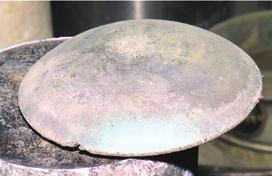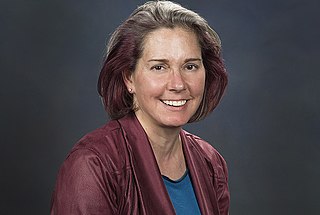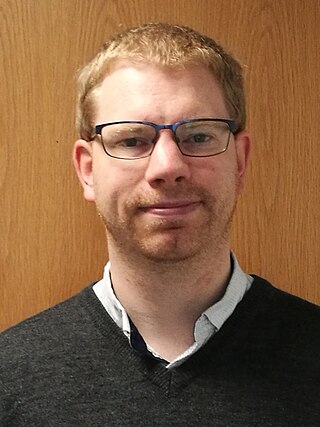Related Research Articles
The actinide or actinoid series encompasses the 15 metallic chemical elements with atomic numbers from 89 to 103, actinium through lawrencium. The actinide series derives its name from the first element in the series, actinium. The informal chemical symbol An is used in general discussions of actinide chemistry to refer to any actinide.
The lanthanide or lanthanoid series of chemical elements comprises the 15 metallic chemical elements with atomic numbers 57–71, from lanthanum through lutetium. These elements, along with the chemically similar elements scandium and yttrium, are often collectively known as the rare-earth elements or rare-earth metals.
Neodymium(III) chloride or neodymium trichloride is a chemical compound of neodymium and chlorine with the formula NdCl3. This anhydrous compound is a mauve-colored solid that rapidly absorbs water on exposure to air to form a purple-colored hexahydrate, NdCl3·6H2O. Neodymium(III) chloride is produced from minerals monazite and bastnäsite using a complex multistage extraction process. The chloride has several important applications as an intermediate chemical for production of neodymium metal and neodymium-based lasers and optical fibers. Other applications include a catalyst in organic synthesis and in decomposition of waste water contamination, corrosion protection of aluminium and its alloys, and fluorescent labeling of organic molecules (DNA).

Europium(III) chloride is an inorganic compound with the formula EuCl3. The anhydrous compound is a yellow solid. Being hygroscopic it rapidly absorbs water to form a white crystalline hexahydrate, EuCl3·6H2O, which is colourless. The compound is used in research.

Organoactinide chemistry is the science exploring the properties, structure, and reactivity of organoactinide compounds, which are organometallic compounds containing a carbon to actinide chemical bond.

Kenneth Norman Raymond is a bioinorganic and coordination chemist. He is Chancellor's Professor of Chemistry at the University of California, Berkeley, Professor of the Graduate School, the Director of the Seaborg Center in the Chemical Sciences Division at Lawrence Berkeley National Laboratory, and the President and Chairman of Lumiphore.
Stephen T. Liddle FRSE FRSC is a British professor of inorganic chemistry at the University of Manchester. He is Head of Inorganic Chemistry and Co-Director of the Centre for Radiochemistry Research at the University of Manchester since 2015.

Polly Louise Arnold is director of the chemical sciences division at Lawrence Berkeley National Laboratory and professor of chemistry at the University of California, Berkeley. She previously held the Crum Brown chair in the School of Chemistry, University of Edinburgh from 2007 to 2019 and an Engineering and Physical Sciences Research Council (EPSRC) career fellowship.

Actinide chemistry is one of the main branches of nuclear chemistry that investigates the processes and molecular systems of the actinides. The actinides derive their name from the group 3 element actinium. The informal chemical symbol An is used in general discussions of actinide chemistry to refer to any actinide. All but one of the actinides are f-block elements, corresponding to the filling of the 5f electron shell; lawrencium, a d-block element, is also generally considered an actinide. In comparison with the lanthanides, also mostly f-block elements, the actinides show much more variable valence. The actinide series encompasses the 15 metallic chemical elements with atomic numbers from 89 to 103, actinium through lawrencium.

Many compounds of thorium are known: this is because thorium and uranium are the most stable and accessible actinides and are the only actinides that can be studied safely and legally in bulk in a normal laboratory. As such, they have the best-known chemistry of the actinides, along with that of plutonium, as the self-heating and radiation from them is not enough to cause radiolysis of chemical bonds as it is for the other actinides. While the later actinides from americium onwards are predominantly trivalent and behave more similarly to the corresponding lanthanides, as one would expect from periodic trends, the early actinides up to plutonium have relativistically destabilised and hence delocalised 5f and 6d electrons that participate in chemistry in a similar way to the early transition metals of group 3 through 8: thus, all their valence electrons can participate in chemical reactions, although this is not common for neptunium and plutonium.

Jaqueline Kiplinger is an American inorganic chemist who specializes in organometallic actinide chemistry. Over the course of her career, she has done extensive work with fluorocarbons and actinides. She is currently a Fellow of the Materials Synthesis and Integrated Devices group in the Materials Physics and Applications Division of Los Alamos National Laboratory (LANL). Her current research interests are focused on the development of chemistry for the United States’ national defense and energy needs.
William J. Evans is a Distinguished Professor at the University of California, Irvine, who specializes in the inorganic and organometallic chemistry of heavy metals, specifically the rare earth metals, actinides, and bismuth. He has published over 500 peer-reviewed research papers on these topics.
Robert Guillaumont is a French chemist and honorary professor at the University of Paris-Saclay in Orsay (1967-1998), Member of the French Academy of Sciences and the French Academy of Technologies
Jonathan Richard Lloyd is a professor of geomicrobiology and director of the Williamson Research Centre for Molecular Environmental Science, and is based in the Department of Earth and Environmental Sciences at the University of Manchester. His research is based at the interface between microbiology, geology and chemistry. His research focuses on the mechanisms of microbial metal-reduction, with emphasis on the environmental impact and biotechnological applications of metal-reducing bacteria. Some of the contaminants he studies include As, Tc, Sr, U, Np and Pu. Current activities are supported by funds from NERC, BBSRC, EPSRC, the EU and industry. Lloyd is also a senior visiting fellow at the National Nuclear Laboratory, which helps support the development of a nuclear geomicrobiology programme.

David Paul Mills is a British chemist and a Professor in the Department of Chemistry at The University of Manchester. His research typically investigates the chemistry of the lanthanide and actinide f-block elements. This is generally based on the synthesis of new f-block complexes, structural and bonding properties and their uses in different fields including in nuclear fuel cycles, energy and single molecule magnets.
Eric John Logan McInnes is a British chemist and a Professor in the Department of Chemistry at The University of Manchester. His research in general is based on inorganic chemistry and magnetochemistry, specifically on molecular magnetism, EPR spectroscopy and coordination chemistry.

Thomas Albrecht-Schönzart is an American radiochemist specializing in the chemistry and physics of transuranium elements. He is jointly appointed as a University Distinguished Professor at the Colorado School of Mines in Golden, Colorado, and Director of the Nuclear Science & Engineering Center as well as a scientist at Los Alamos National Lab.

Marinella Mazzanti is an Italian inorganic chemist specialized in coordination chemistry. She is a professor at EPFL and the head of the group of Coordination Chemistry at EPFL's School of Basic Sciences.
Curium compounds are compounds containing the element curium (Cm). Curium usually forms compounds in the +3 oxidation state, although compounds with curium in the +4, +5 and +6 oxidation states are also known.
Einsteinium compounds are compounds that contain the element einsteinium (Es). These compounds largely have einsteinium in the +3 oxidation state, or in some cases in the +2 and +4 oxidation states. Although einsteinium is relatively stable, with half-lives ranging from 20 days upwards, these compounds have not been studied in great detail.
References
- 1 2 3 4 5 6 University of Manchester. "Dr. Louise Natrajan" . Retrieved 12 June 2020.
- 1 2 Royal Society of Chemistry. "Bill Newton Award/Lectureship" . Retrieved 12 June 2020.
- 1 2 Patmore, Nathan J; P Elliott, Paul (23 November 2018). Organometallic Chemistry: Volume 42. England: Royal Society of Chemistry. p. viii. ISBN 978-1-78801-067-2.
- 1 2 "Dr Louise Natrajan:Publications" . Retrieved 12 June 2020.
- ↑ Natrajan, Louise Sarah (2003). Lanthanide and Group (IV) (OSO) binaphtolates : synthesis and catalysis (PhD thesis).(subscription required)
- 1 2 3 "About Dr. Louise Natrajan" . Retrieved 12 June 2020.
- ↑ "Dr. Louise Natrajan, Outreach" . Retrieved 12 June 2020.
- ↑ "Radioactivity - The Glowing Future" . Retrieved 12 June 2020.
- ↑ University of Manchester. "Dr Louise Natrajan (Women of Wonder)" . Retrieved 12 June 2020.
- ↑ Royal Society of Chemistry. "10th International Conference on Nuclear and Radiochemistry– NRC10" . Retrieved 12 June 2020.
- ↑ The Nuclear Institute. "Women in Nuclear UK" . Retrieved 12 June 2020.
- ↑ Vettese, Gianni F.; Morris, Katherine; Natrajan, Louise S.; Shaw, Samuel; Vitova, Tonya; Galanzew, Jurij; Jones, Debbie L.; Lloyd, Jonathan R. (2020). "Multiple Lines of Evidence Identify U(V) as a Key Intermediate during U(VI) Reduction by Shewanella oneidensis MR1". Environ. Sci. Technol. 54 (4): 2268–2276. Bibcode:2020EnST...54.2268V. doi: 10.1021/acs.est.9b05285 . PMID 31934763.
- ↑ Woodward, Fred; Wilson, Hannah; Natrajan, Louise S (January 1, 2001). "Multiphoton and upconverted excitation of lanthanide(iii) ions in coordination complexes". In Patmore, Nathan J; Elliott, Paul I P (eds.). Organometallic Chemistry. Vol. 42. Book Publishers. pp. 172–189. ISBN 978-1-78801-067-2.
- ↑ "Newton Bhabha Researcher Links Workshop (Official Website)" . Retrieved 12 June 2020.
- ↑ "Newton Bhabha Researcher Links Workshop" . Retrieved 12 June 2020.